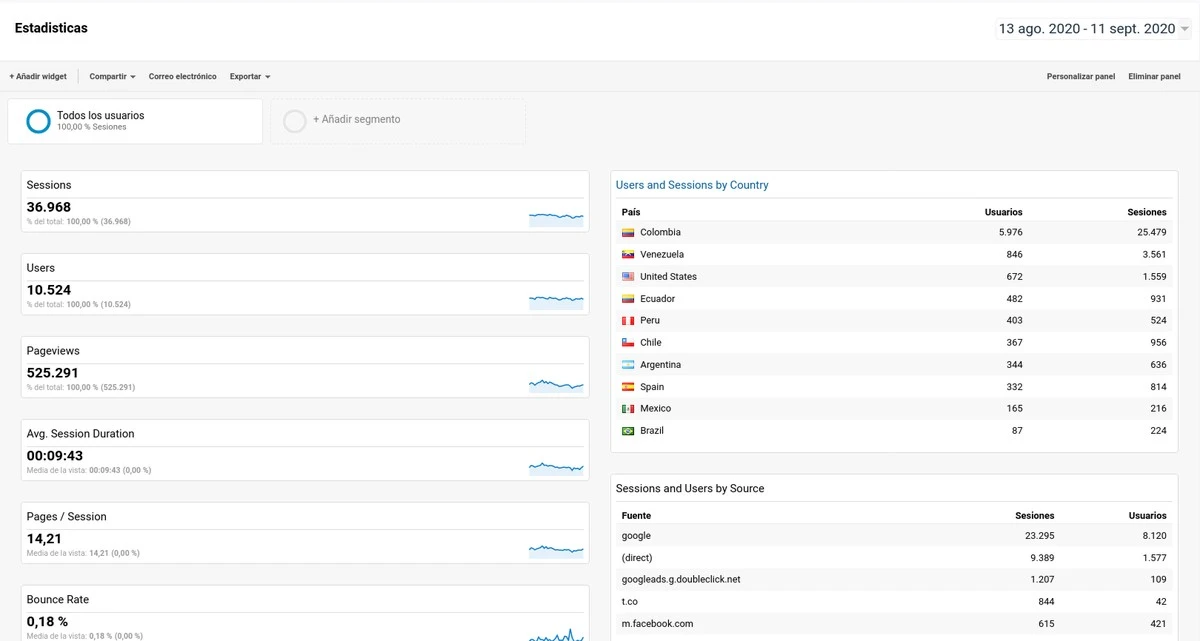First, I want to clarify that the following text is my experience in searching for a specific need. I am not an expert in digital marketing or any related subject. I believe this experience can contribute something to novice users in the field. Now, let’s begin. Since 2012, I have been managing a community focused on military topics around the world, with a greater emphasis on America. This community is economically sustained through advertising, and since its inception, we opted for Google Adsense. The money obtained from advertising was sufficient to cover the costs of hosting and maintenance.
For eight years, we did not encounter major difficulties, just a couple of warnings from Adsense about certain types of content, but nothing significant. These were things that could be corrected, and to avoid future problems, we excluded advertising in some sections that we considered inappropriate for all audiences, but it was nothing major.
In 2019, I decided to try the option of auto ads (AutoAds), and everything was going smoothly. The automatic management of ads seemed correct and worked very well. However, in August 2020, something changed. The ads started appearing in a very invasive area of the website, completely altering the design. The affected area was the navigation bar, which is fixed. The advertising ads appeared in the middle, disrupting the site’s menu and covering the content. While it wasn’t too bothersome for those browsing from computers or large screens, it was a more significant problem for those using mobile devices. In some cases, the ads covered between 50% and 70% of the website content.


Adsense in the control panel has an option to indicate where you don’t want ads to appear. Unfortunately, the navigation bar did not have the option to deselect, indicating that no advertising should appear in that place. Despite contacting technical support to resolve this issue, two days later, Google decided to disable all advertising on the website, citing the following reasons:
- Include explicit, disgusting, or unpleasant descriptions or images.
- Show violent acts.
This was a great and unpleasant surprise since we have always been careful with the site’s content, and the rules are very strict in this regard. The moderators ensure that these rules are strictly followed. The only “redeeming” aspect of this situation is that only the website was disabled, not my Adsense account, with which I have other registered projects.
A bit about the website
The website is a military-themed forum, completely in Spanish, with an average of over 500k monthly views and 80% of traffic coming from Latin America. To give you an idea of the website’s traffic, here’s a graph of the visit statistics for the last 30 days when I started this “crusade”:

Additionally, we have a decent presence on social media, a Facebook fan page with 18,562 people who have indicated that they like it and 54,258 followers. There’s also a YouTube channel with 2,370 subscribers, and although the channel is relatively new, with only a year of operation, it has been actively developed in the last three months. Recently, a Twitter account and a Telegram channel were created to promote the content generated within the community. However, the majority of the website’s traffic comes from Internet searches.
The Search Begins
Before starting, it’s essential to know a bit about the monetization methodology. Google Adsense pays for clicks on ads, but they also consider how many times the ad has been displayed and the cost per click (CPC) the ad has received, which varies depending on the advertiser. Another common form, although not as profitable, depending on the website’s traffic content, is the number of ad impressions on the website (CPM). Clearly, with higher traffic, the ad will be displayed more often. The last common form is acquisition, meaning you get paid for each visitor who fulfills a goal set by the advertiser, such as subscribing, affiliating, or purchasing an advertised product or service. I won’t dwell on this topic because there is a lot of information on the Internet, and my goal with this post is to share my experience in this search.
Continuing with the theme, after extensive research on blogs, forums, and YouTube about alternatives to Google Adsense and website monetization, I made a shortlist of possible companies that are well-known and frequently mentioned. Here’s the list of companies and my experience with them:
Media.net: Another giant, responsible for managing the advertising offered by Bing (Microsoft) and Yahoo. They rejected me because the majority of traffic comes from Latin America and due to the content in Spanish. They are focused on the Anglo-Saxon market.
Mediavine: Requires a minimum of 50,000 views per month. The site was rejected, like Media.net, because the primary source of traffic comes from Latin America.
Adthrive: Requires a minimum of 100,000 views per month. Rejected, like the previous two, because of the traffic’s origin, as they are more focused on the US market.
OptAd360: A European company based in Poland. A certified partner of Google, giving them access to Google’s Ad Exchange network. They use the cost per thousand impressions (CPM) monetization methodology. I contacted a Spanish-speaking advisor who provided excellent service. I explained the reason for contacting them and the issue I had with Adsense. They requested some data related to the site’s traffic for the last three months, rejected my application, and rightly so. As Google partners, there was a risk that the site would be blocked again by Adsense for a violation. It could be a good option for sites not having problems with Google Adsense or those waiting for approval from them.
Grumft: A company based in Brazil, focused on the Latin American market. I had a good start, and it seemed very similar to Adsense. I was liking it, but only one type of advertisement appeared. I contacted support, and they said it was a problem with the inventory. I waited two days and received no response. So, I wrote to them again, telling them I was going to remove the ads, and the advisor responded, apologizing for the delay but stating they couldn’t place ads due to the site’s content.
Taboola: Rejected. The response I received was that I didn’t have the minimum required views to work with them. They require a minimum of 500,000 views per month. They offer a type of advertisement known as native ads, a format that simulates a news article. It comes with an image and a sometimes sensationalist title. It’s a format I don’t like as it appears intrusive, unattractive, and of low quality. I have a small experience with this company that I will comment on later.
PopMyAds: This was an innocent choice on my part. The company’s name describes the type of advertising they handle: pop-under ads. These ads open a popup window beneath the active browser window, but they can be invasive. In the hour that I had it active, the only type of advertising it showed was for places or services for those over 18 years old. It might work for some sites, but it’s not the best choice for the forum.
Yllix: Quick approval, and I didn’t see any special requirements. The advertising was of low quality and didn’t integrate well with the site. I used it for a couple of days with very poor results.
PropellerAds: Has some reputation, and it is recommended on some sites. They approved it in a couple of hours. I didn’t like the type of advertising. To access “premium” advertising, special approval is required, which I didn’t request. Maybe I’ll use it for a day.
AdNow: I used it for about two weeks. Thanks to this, I got firsthand experience with the native ads I mentioned when talking about Taboola. They are of very low quality, with content having extreme sensationalist tones and images, though not violent, that stand out due to their rawness. It’s an easy approval place.
Ezoic: Here, I’ll talk a bit more. This is a company that is a certified partner of Google. One of the first ones that asked me, besides adding a JS to the site for confirmation, was to fill out a Google Ad Exchange application to work with them. The website was accepted after a few days. They also ask, although it doesn’t appear as a mandatory requirement, to link my Google Adsense account. I didn’t do this because I wasn’t interested in involving my other sites at the time. In a few days, I received an email from an advisor who asked for the site’s statistics for the last three months. They asked me about the site and the goals I wanted to achieve with it. After sending the answers, I received another email to schedule a video conference with the advisor. This took place five days later, and the conversation was entirely in Spanish. The advisor was very friendly, explained how the company works, and the way to generate better income, something they call machine learning, which, as the name suggests, learns about the site, its behavior, and chooses the type of advertising, where it should appear, the quantity, etc., to achieve maximum performance. Continuing the conversation with the advisor, he asked me a couple of very specific questions about certain content on the site. He also gave me some recommendations that I had to follow. After this, I was asked to request a new review by Google Adsense to approve the site again. At this point, things didn’t make sense to me. I was looking for an alternative because that content couldn’t be changed. Additionally, I was afraid that a second review would affect my Google Adsense account. This made me end the process with Ezoic. It might be very useful for someone who wants to boost their earnings with Adsense, but I didn’t see it as an alternative in my case.
Amazon’s affiliate marketing program: Amazon’s affiliate program is a form of acquisition monetization. It’s not bad for sites that review products, as it leaves a link to the product for visitors to purchase through Amazon’s store, and the site receives a commission for that sale. It’s straightforward to join the affiliate program, they don’t ask for much, and you can register multiple sites. However, they require that a product be sold to confirm the account within 90 days. Highly recommended but not ideal for the site.
For now, this is what I had found. There are many options, each with its advantages or disadvantages. Google Adsense is not perfect either. Also, shortly after starting my search, I received another email from Adsense informing me that the payment method, Western Union, which was available until January 2021, would no longer be available for my country. Bank transfers, the other option for receiving payments, have very high commissions in Colombia, making that type of monetization unviable for small websites like the community I manage. But not all was lost in my search, which I will discuss in the next blog post. I want to talk in detail about my experience with the company I am currently working with.
I will leave a couple of links that have helped me in all this search:
- 21 Best AdSense Alternatives to Consider for Your Website in 2020.
- Alternatives to Google AdSense.
- ForoBeta, I recommend this forum in particular, a very good source of information for every webmaster. The people are friendly, and the responses I’ve received from some users have been very helpful.